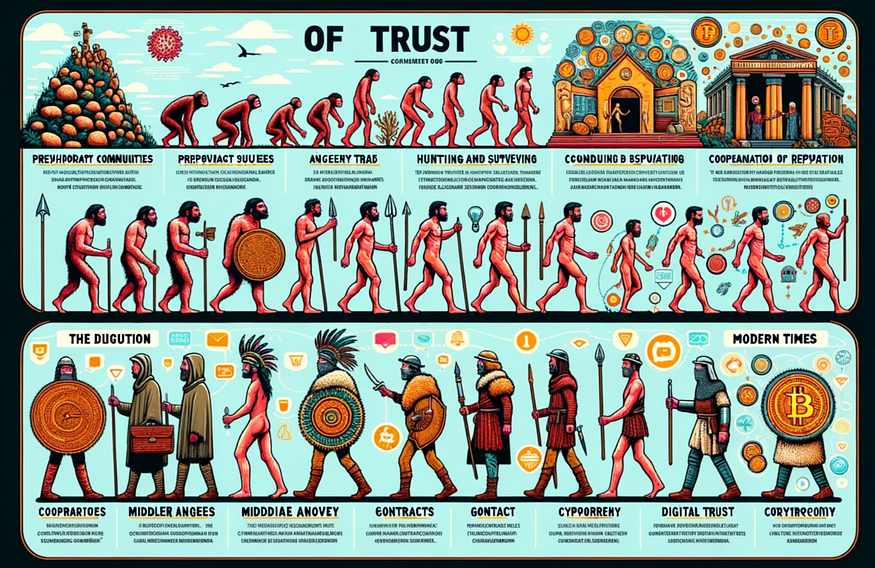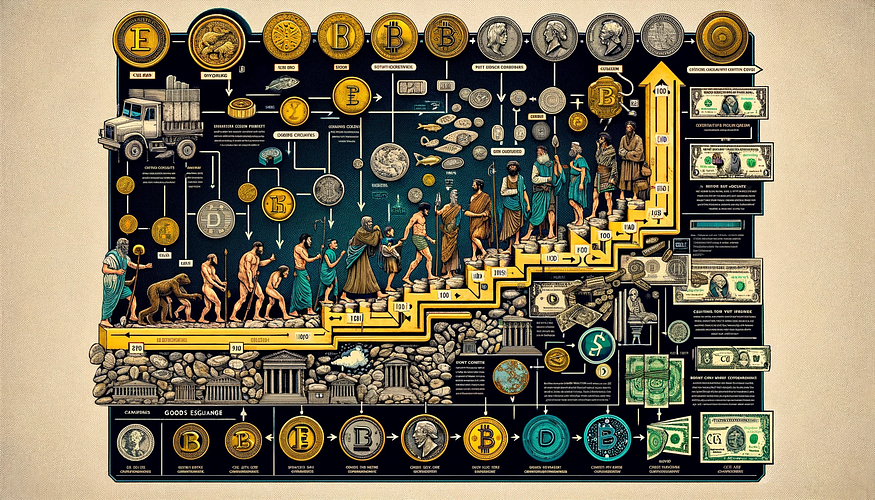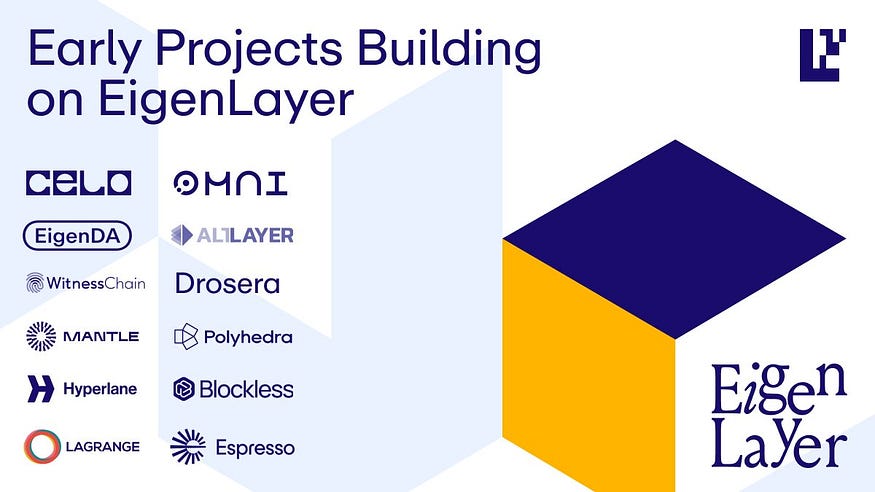Programmable Security: EigenLayer-EigenDA
1. What is Trust:
“A person or group's feelings towards another person or group; It is a sense of honesty and good will.”
Since the beginning of human history, trust has been a concept that forms the basis of societies and shapes the core of human relations. Trust; It was necessary first for survival, then for hunting and gathering activities, and then for the social structure after the social structure was formed. As we approach today, trust has become the main element of our modern society, especially economy and law, mostly provided by governments. Dall-E — Visual on the Evolution of Trust
Dall-E — Visual on the Evolution of Trust
Trust has been at the heart of commerce since the early days of commerce. While people trust that in the first exchange transactions, the other party does not sell fake goods and that the value of the goods is equal to their own goods; Afterwards, they trusted in gold and that the gold supply could not increase randomly and used it as the main currency. Currently, we rely on governments for the currencies used. Governments give us a piece of paper (or a few increasing numbers on our phone application), we attach value to them and use them in payment systems in our daily lives. The Evolution of Money — Dall-E
The Evolution of Money — Dall-E
Yes, the topic we will talk about today is; The digital age, the changing trust phenomenon of this age and EigenLayer trying to make this phenomenon programmable.
2. Trust in the Digital Age: Blockchain and Game Theory
It is an undeniable fact that governments have been the main authority that ensured trust for centuries. "Anarchist" people who reject this authority and do not accept the existence of governments have tried to reject this authority and create different concepts of trust since the early days. When we came to the digital age, both our lost privacy and the increasing authority power mobilized a number of activists and "cryptoanarchism" was born.
Cryptoanarchism explains that it is now possible for people to communicate with each other without their identities through systems that rely on mathematics and computers, and that this will and should change the entire structure of society as we know it. He puts forward certain ideas so that the society, not the central actors, will win in this changing social structure.
Cryptoanarchists have worked for many years for systems that do not require trust in humans, but failed until Bitcoin. Then a crazy engineer named Satoshi, whose name, identity, location and even gender we do not know; He developed Bitcoin and the blockchain concept and introduced it to the digital age. Since then, our concept of trust has never been the same again.
Bitcoin created an infrastructure that took trust from a center or group and gave it to mathematics and game theory. This infrastructure worked simply like this: Alice wants to send BTC (Bitcoin's native currency) to Bob, for this Alice adds some BTC as a commission and sends it to a network.
In this network, miners receive commission for BTC transfer and will be rewarded with extra BTC reward if they “act honestly”. It then incorporates this transaction into the block and propagates it to other participants in the network. If everyone agrees, our miner receives the reward and continues working to find a new block.
What I really want to explain here is how the trust mechanism in Bitcoin works, rather than how Bitcoin works. Here, miners have their computers solve challenging mathematical problems and find the block that solves this problem first. If a miner includes an invalid transaction in the block or engages in “bad behavior,” the rest of the network will see this and that bad behavior miner will not receive the block reward. Bitcoin is based on the game theory that miners will act honestly to get this block reward.
Although Bitcoin paved the way for decentralized trust and payment systems, it had a problem: It could only be used for payment systems and had limited programmability.
There is a completely different game in Ethereum. Actors who approve the network receive an amount of Ether upfront, provided they act honestly, they receive the Ether reward. Unlike Bitcoin, bad behavior (Note: the types of bad behavior here are very different and I chose this as the most appropriate translation for malicious behavior in Turkish. I apologize if it caused confusion) results not only in not receiving the rewards, but also in burning the Ethers locked by the validators.
This trust in both Bitcoin and Ethereum gives rise to the new trust phenomenon of the digital age: “cryptoeconomic trust”.
3. Programmable CryptoEconomic Trust: EigenLayer
PoS (Proof of Stake) systems, especially Ethereum, provide trust simply as follows: people who approve the network lock a certain amount of assets, the approver is rewarded as long as they act honestly; If they do not act honestly, they are punished by burning their locked assets.
The biggest problem of these systems is that every application that needs cryptoeconomic trust has to build its own security from scratch. Each application ensuring its own security has some consequences:
- The problem of “fragmentation of economic security” as each application creates its own economic security
- It is not possible for every application to issue tokens, and dysfunctional or incorrectly designed tokens make it impossible to build the game theory of the network.
EigenLayer re-stakes staked tokens in Ethereum; It offers an infrastructure that makes it possible to partially lease the cryptoeconomic security of Ethereum. (I will explain partly why this is in a moment)
Thanks to this infrastructure, developers can build their own applications by renting security from Ethereum without issuing a new token. This can be used to keep data securely in any database, for decentralized sorting, for a bridge project or to develop a new chain.
3.2 What Exactly is EigenLayer?
EigenLayer is nothing more than a series of smart contracts living on Ethereum. This smart contract supports token deposit, withdrawal and slash. The point I want to emphasize here from the structure below is that everything is done completely outside the chain and by the actors called operators.
So, when you re-stake your staked token in EigenLayer, you trust that the operator you delegate to is honest, because bad behavior by your operator will result in your Ether being burned. This is actually a problem with the delegation system in most dPoS (Delegated Proof of Stake) systems, but you are taking on an additional risk that is not included in Ethereum's main protocol. The same goes for LSTs.
4. Blockchains Are More Than CryptoEconomic Security, and You Can't Rent It: Autonomous Communities.
The main fact that actually provides security in Ethereum and Bitcoin is not cryptoeconomic security, but the dominance of the community outside the chain. Even if the majority of validators or miners behave badly or there is a problem with the chain's software, the community can fork the chain and invalidate previous transactions. What EigenLayer cannot rent and inherit from Ethereum is the trust provided by this community that takes place off-chain.
Vitalik also mentioned this in his Don't overload Ethereum's consensus article. He advised that your double staking & restaking applications should not depend on Ethereum for slash and should not add additional burden to Ethereum's simple consensus.
I think it's very important to be aware of the security trade-off here (not being able to rent the community outside the chain) and that the rented security is cryptoeconomic security. Apart from this, EigenLayer opens a huge door to innovation and innovation for Ethereum. Many applications have already started developing on EigenLayer.
5. EigenDA
I will not explain Rollup and Blockchain from scratch here, but the Data Availability layers; Based on their market strategies, I will explain “which one is better (!)” and their differences.
Full nodes in blockchains are more powerful than you think. Even if all participants confirming the chain confirm an invalid transaction, your own full node can understand that this transaction is invalid and you can confirm what is correct in the chain “without needing trust”. My Full Node Against Invalid Transactions (not representative)
My Full Node Against Invalid Transactions (not representative)
Although full nodes are very powerful, currently establishing a full node from scratch is both very laborious and expensive for the end user. That's why there are light nodes that we call Light Client. They trust that the majority of full nodes are honest, so unfortunately there is a situation based on trust.
DAS (Data Availability Sampling) is a method that allows users to confirm that the data on the chain is there and valid without downloading all the blockchain data. Currently, Celestia is trying to make this possible with fraud proof and Avail with zero knowledge proofs. In this way, it tries to produce larger blocks and increase the data capacity of the blocks.
We can see this especially in the Sovereign Rollup on Celestia. By running rollup and Celestia's light node, users can participate in the blockchain without having to trust anyone. Sounds great, right? So how many Sovereign Rollups are currently running on Celestia? 0.
So where is Celestia currently used? Celestia's main use case is providing cheap data accessibility to rollups on Ethereum. Although this sounds good, there is a big shortcoming: Ethereum L2s using Celestia cannot gain direct advantage from Celestia DAS. The main reason for this is that it is not possible to confirm DAS in Ethereum. Since the bridge that proves Celestia to Ethereum only checks whether 66% of Celestia validators have signed the transaction, any Ethereum Rollup cannot benefit from Celestia's innovative technology.
The same problem applies to Avail, but I know they have plans for this. I won't talk about it here since they haven't shared it openly yet.
Let's talk about the EigenDA project: EigenDA is an application that uses EigenLayer and provides DA services to Ethereum rollups. Yes, I say application because EigenDA is not a blockchain, it is just an efficient database. This database provides services to Ethereum, Data Availability Oracle, Rollups and all applications that need data accessibility. Since there is no blockchain, a light client or similar concepts do not exist in EigenDA. I won't go into technical details, but it offers higher efficiency + cheaper than its competitors. As I mentioned in previous sections, EigenLayer “only” provides cryptoeconomic security to applications. In this sense, EigenDA, Celestia, and Avail may seem to be equal in terms of cryptoeconomic security; EigenDA can even offer higher cryptoeconomic security with restaking, but there is a very important nuance: While Sovereign Rollups on Celestia and other users running light clients can punish the (possible) bad behavior of Celestia validators; In EigenDA it just depends on the operators. So punishing evil is easier in Celestia. :)
While Sovereign Rollups on Celestia and other users running light clients can punish the (possible) bad behavior of Celestia validators; In EigenDA it just depends on the operators. So punishing evil is easier in Celestia. :)
All three projects have significant advantages in themselves, and I try to understand the innovations created by all of them and make improvements on them.
The new trust phenomenon brought by the CryptoAnarchist world: I think we will see the importance of EigenLayer, which takes cryptoeconomic trust to the next level, much more in the future.
Thank you for reading!





































